Climate change
The hallmark of climate change is the upwards trend in temperatures but the attendant prejudice is very important.
That temperatures are rising is an established fact. Although the rise in global temperature is estimated to be of the order of 1.2
oC since 1940-1960. This is equivalent to a land altitude reduction of 200 metres. However, the evolution of impacts on agriculture are detectable by prejudice in lower reaches of land areas which will be the first to be affected by rising temperatures. These events are associated with a variation in the weather over a four to five-year cycle.
Examples as evidence of the impact of climate change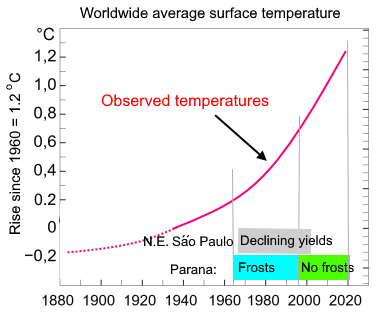
Frost in the State of Parana in Southern Brazil, occurring on average every 4 years in the areas south of the 23rd parallel South during the period 1965 through 1995. This resulted in falls in yields in the following years. At the time Brazil produced 60% of the world coffee production so this was a serious issue given the inelasticity of demand for coffee generating significant price rises and market instability.
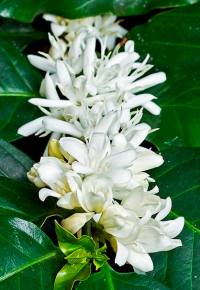
Therefore, coffee production was moved to bioclimatic zones further North and closer to the Equator, with less frost incidence. However, with global warming, for example in lower altitude regions of North East São Paulo State, farmers experienced a period during which coffee yields began to fall quite dramatically. The farms experiencing this evolution were applying their variable inputs as recommended and the varieties were adapted to the region (AEZ) and as recommended by the best current professional advice via extension. However, the reason for the dramatic fall in yields was climate change-related rises in ambient temperature. In the coffee plant flowering period, which starts around April to flower maturity in around June in the Southern Hemisphere, the ambient temperature, on occasions, had exceeded 33
oC. This temperature is fatal for the coffee flowers which are extremely delicate. As a result, there was no pollination or fruit formation (berry) and therefore no production of green berries or only a very low yields gathered from plants at higher altitudes and which had not been exposed to the 33
oC temperature.
As a result, coffee production migrated to cooler higher altitudes in the State of Minas Gerais.
In the meantime, where frost had been occurring in Parana State in the past, for the last 15 years there have been no frosts as a result of global warming. As a result, some coffee production returning to that State.
1

In its basic form we are interested in "sustainability" in the sense of the renewable natural resources of the planet not being overwhelmed by the increasing consumption levels of a rising human population and the use of inappropriate technologies used to produce basic human needs.
Climatic averages and meteorological varianceThe leading edge of the impacts of increasing climate change prejudice is the rise in temperatures regimes associated with seasons with above average temperatures. For example in the 4-5 year cycles in seasonal associations of different temperature and water regimes, the warmer occasions are the most destructive because these can result in the ambient temperature rising by up to 5
oC above the average. Therefore in the case of the example of coffee flower destruction, this would have been initiated in a warmer seasonal variance year where coffee yields would have suffered but in the following years the temperature could be even less than average but in subsequent years the temperature rises would be correspondingly at a higher level affecting more of the crop and becoming more noticeable.
The typical attendant issues with the years experiencing a variance into higher temperature levels is that evapotranspitation also rises so that thousands of additional cubic metres of water enter the atmosphere leading to larger volumes of downpours causing additional damage in the form of mud slides, soil erosion and other forme of destruction.
MGPF representation of the carbon capture in plant biomass
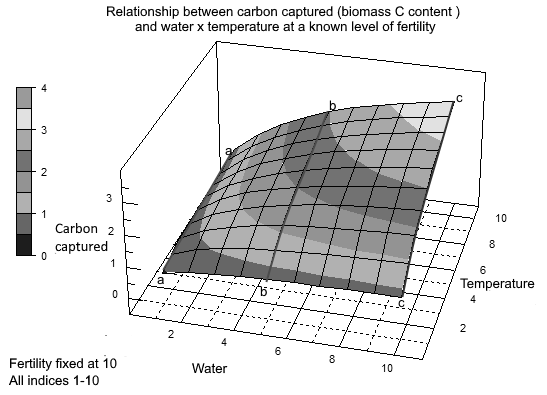 |
|
|
At the moment, the human race is failing to slow down the rate of growth in the population size or to change technologies and techniques so as to stabilize the carrying-capacity of renewable resources. There is much emphasis on "environmental concerns" and "climate change" but in reality the 2019 Sustainable Development Report published by the United Nations has pointed to the fact that there is a direct correlation between "economic growth" and increasing levels of income disparity, declining production and consumption sustainability and negative impacts on the climate in the form of rising temperatures.
Sustainability performance criteriaIn the agricultural sectors which employ the majority of the world's population, the current performance of a farms can be determined by applying the established criteria by the Open Quality Standards Initiative (OQSI) which are measured determined in terms of their relationship to objectives, in this case sustainability:
- Relevance
- Effectiveness
- Efficiency
- Impact
- Coherence
- Resilience
- Sustainability
|
The components of sustainabilityThe locational-state modelThe locational-state model links the principal determinant values to a target property state value. However, although a locational state model can represent long term climatic average determinant states the same model can also be used to represent any combination of states (determinant values) and from year to year and these combinations will change as shown in the examples concerning barley production in the agrobiometrics page. The advantage of the locational-state model is that it can accommodate any event probability concerning the value of the property of any determinant and generate the associated target property state value. Therefore it is possible to assign a value to the resulting target property state value measured in terms of biomass, yield, gross margin, real incomes, carbon footprint or carrying capacity.  The utility of this type of model is that it not only describes the complex determinant relationship it also provides a means of predicting yields (B) based on the progress in determinant values during a production season. Thus, instead of comparing and end of year yield to the average long term yields it is perhaps more useful to know where yields will end up in the current production year based on real time monitoring of mainly temperature (T) and water deficit (W) regimes. By modifying inputs to accompany seasonal conditions by applying then according to need some economy in production costs can be achieved in many cases. |
|
|
Sustainability, as a domain of analysis, is made up of several components including:
- Social
- Real Income
- Financial return
- Costs
- Technology
- Environment
- Ecosystem
- Climate change
- Carrying capacity
The combination of these two sets of criteria can be observed in the OQSI critical path for sustainability and climate action below.
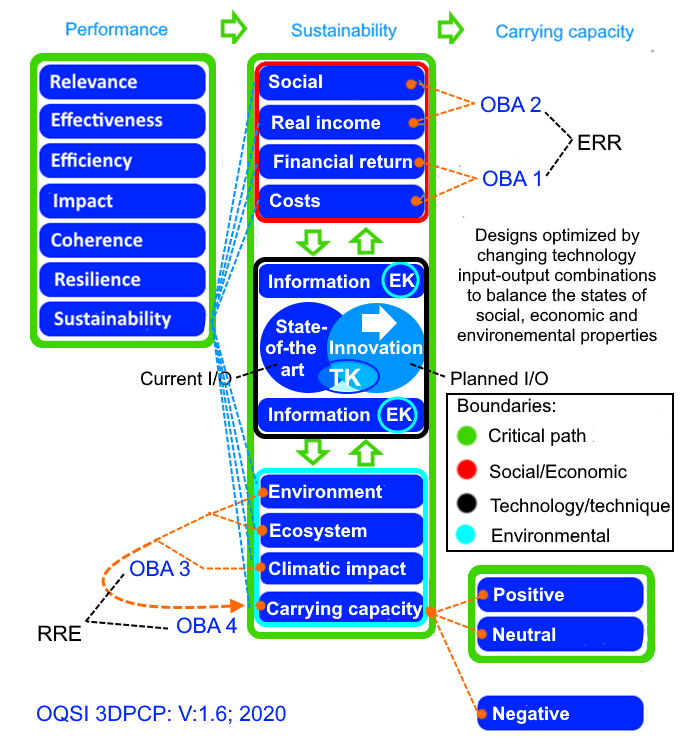
Depending on the degree of adjustment required to improve performance on one or more aspects of sustainability it is necessary to compare different input-output combinations of variable inputs. This signifies a change in the technology and techniques applied within the box with the black boundary as a result of a technological adjustment.
Because these adjustments are physical involving changes in inputs linked to social, economic and environmental factors the OQSI critical path model groups these changed as impacts measured as:
- ERR - Economic Rates of Return
- RRE - Rate of Return to the Environment
Options Benefit Analysis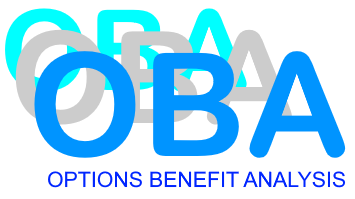
In response to the 2019 Sustainable Development Report that indicated the failures in the Agenda 2030 portfolio as economic growth being correlated to declining real incomes, falling production and consumption sustainability and rising temperatures (climate change), the OQSI accepted proposals from SEEL-Systems Engineering Economic Lab to recommend four types of cost benefit analyses referred to as Options Benefit Analyses (OBAs) where the measured benefits against costs are:
- OBA1 - cost fiancial return analysis
- OBA2 - cost real income return analysis
- OBA3 - cost carbon footprint reduction analysis
- OBA4 - cost carrying capacity state analysis
These are "positive" quantitative determinant procedures that enable a direct confirmation of the impact of a particular solution on real incomes (income disparity), financial return, reduction in climatic impact and overall impact of carrying capacity. Therefore as a basis for designing actions they provide direct measurements of potential impacts of a given technological option.
The ERR essentially compares the cost of the new technical profile measured by the OBA2 which compares the new costs to changes in real incomes which also support social factors related to income disparity or living income. OBA1 compares new costs to changes in the financial return (cost Benefit Analysis).
The RRE essentially compares the new costs to changes in the environment and ecosystem linking natural resource base to ecosystem flora and fauna to climatic impact which will impact ecosystems over time measured by OBA3. And the summary result is the comparison of the new costs to the resulting carrying capacity of a project site applying OBA4.
The ERR calculations fall within the red box within the critical path and the RRE calculations within the turquoise box within the critical path.
A satisfactory state is where all criteria and Options Benefit Analyses within the green boundaries generate a carrying capacity that also falls within the green critical boundary as positive or neutral.
The locational-state determinant relationship of, for example yield or biomass production of a crop is shown below.
Stp = D(W,T,N,P,K,E,H,G) ... (i)
Where:
Stp is the State of the target property, in this case biomass;
D id the determinate function;
W is the water regime;
T is the temperature regime;
N is the available nitrogen applied;
P is the available phosphorus applied;
K is the available potassium applied
E is the energy used e.g. liquid fuels
H is the human resources used
G is the genotype (variety) and quantity of seed used.
1 Video produzido por UNICAMP "Hilton Pinto sobre desenvolvimneto de zoneamento agroecologico no Brasil."
